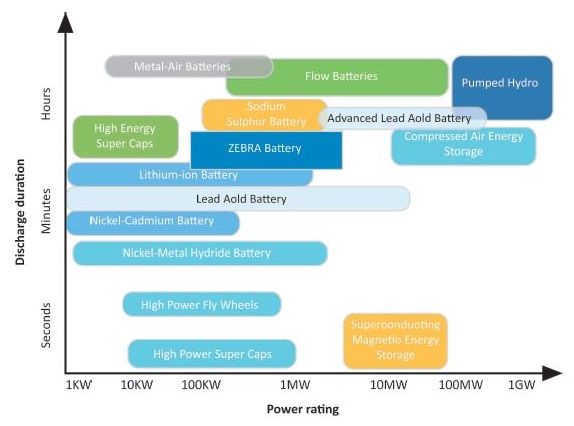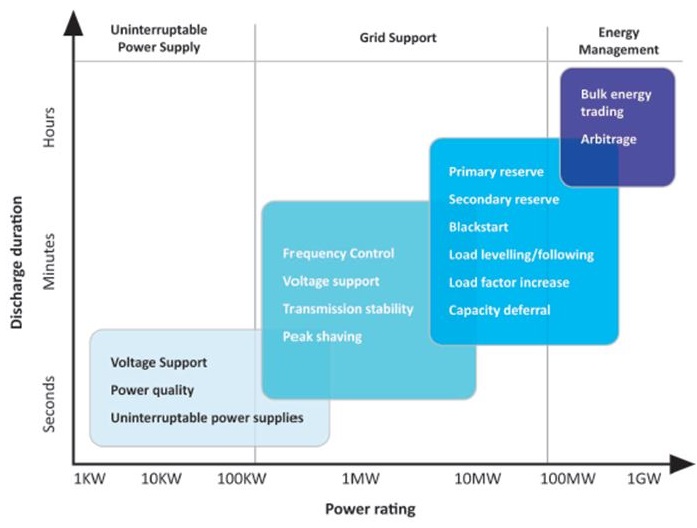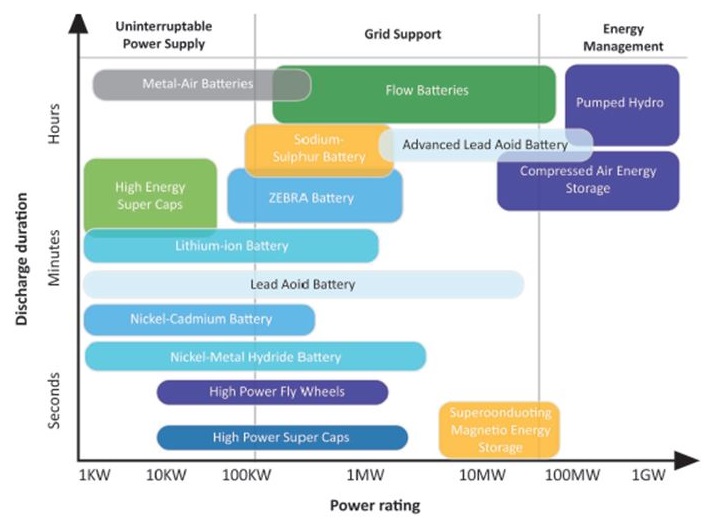Energy storage - the missing piece?
Contents |
[edit] What is energy storage?
The term ‘energy storage’ encompasses a wide range of technologies with diverse capabilities.
Available storage options span the two dimensions of power rating and discharge duration. Low power rating and short discharge duration options such as super-capacitors and batteries are better suited to provision of services to distribution network operators and end-users, while high power rating and long discharge duration, such as pumped storage hydro, are well suited to providing energy management and balancing services to transmission system operators.
Pumped water storage is well established, and accounts for the great majority of schemes, however, it is relatively inefficient as it involves converting electricity into kinetic energy, then to potential energy and then back into electricity. It generally requires hilly terrain, although low-lying Denmark has pioneered the reverse concept of a 'green power island', where sea water is pumped out of areas and then let back in through power generating turbines.
[edit] Forms of energy storage
(Figure 1: Wide range of storage technologies. Source: UK Power networks)
Other forms of energy storage include:
[edit] Thermal storage
Technologies for ice and heat storage already exist but further improvement can be made to increase efficiency and investigations are on-going on phase change materials (PCM). Further deployment should be achieved in smart cities and building applications, such as centralised air-con systems incorporating ice storage; CHP plant equipped with heat storage; or thermal storage in renewable systems.
[edit] Compressed air energy storage (CAES)
This is attractive but needs to cope with the issue of heat exceeding 650C that can be generated during the air compression process.
[edit] Flywheel
Further improvements of this mature technology will be on safety, cost reduction in high capacity storage, and reduction of self-discharge.
[edit] Supercapacitor
In order to solve the low energy density and high capital cost issue, the industry is investigating lithium-ion capacitor systems; finding new electrolytes capable of voltage beyond 2.7 V and with less toxicity; exploring new materials that have very low cost and low environmental impact and can produce high-performance, such as activated carbon, metal oxides.
[edit] Hydrogen storage
It still early to predict when this will become a commercially viable solution. Current R&D is on improving efficiency at high temperature and reduced cost.
Much work is going into developing more affordable, large-scale and reliable storage systems, most obviously batteries, including those for domestic energy storage from home photovoltaic (PV) systems, and from electric vehicle batteries (smart cars) to feed power back into the grid at times of peak demand.
[edit] How can storage be used?
(Figure 2: Range of applications. Source UK Power Networks.)
The technical diversity of energy storage technologies means that they can be deployed for a wide range of applications.
Broadly, the range of applications spans uninterruptable power supply (UPS), providing end-users with security and quality of electricity supplies; to grid support, providing services to distribution and transmission network operators to deliver system stability, manage peak load, voltage & thermal contracting management and balancing services; as well as energy management for bulk energy trading.
[edit] Status
Today, the majority of storage technologies are in research and development, early commercialisation or demonstration phases.
Costs are of course, expected to reduce as the technologies develop and deployment increases but achieving greater deployment relies upon a valid business case for projects both now and in the
longer-term if energy storage is to be deployed in both the smart grid and as an integral part of smart buildings.
Development of new battery technologies is focusing on lifecycle cost, energy density (size), safety, operating temperature and degradation. Many new technologies are under demonstration, prototype, laboratory and concept stage. Broadly, the various stages of development include:
- Commercialised: lead-acid, sodium-sulphur, lithium-ion.
- Demonstration: zinc bromine, advanced lead-acid, vanadium redox, nickel-metal hydride, lithium-ion.
- Prototype: lithium-ion, iron chromium, and high power, high temperature “ZEBRA” batteries.
- Laboratory: zinc-air, advanced lithium ion, and other lithium based types.
- Conceptual: nano supercapacitors, new electrochemical couples (metal-air, Na-ion, Mg-based, etc).
[edit] Cost
(Figure 3: Mapping storage technologies to range of services)
Apart from cover over short periods, battery storage has been prohibitively expensive; however lead-acid and lithium batteries are now commercially available in Europe for about €1,000/kWh. And in a country with high consumer electricity prices, such as Germany, PV with battery storage can have a lower unit price than mains electricity.
Meanwhile, in 2015, US electric car manufacturer Tesla, launched “Powerwall” battery storage aimed at the residential market and providing 10 kWh for about $3,500, and Mercedes launched a 2.5 KwH home battery. Combining up to 8 can provide a total of 20 KwH. Allowance must also be made for the cost of a battery management system and installation.
A study for the Australian Renewable Energy Agency in July 2015 found: “The potential for significant cost reduction of some battery technologies provides real opportunity for significant deployment in multiple applications. In particular, Li-ion batteries prices are expected to reduce by over 60% and flow battery prices by over 40% by 2020.”
[edit] Deployment
Estimates show that at least 220 MW of energy storage was deployed in 2015, the majority of which was utility-based and the balance non-residential. By 2020, at least 1660 MW is forecast to be deployed, of which about 48% would be utility-based, 24% non-residential, and 28% residential.
Various sources put the value of this market at between $16-21 bn by 2020 and reaching in excess of $60 bn by 2030. Of global installed capacity, the Americas accounts for just under 1/2, APAC for 1/3 and EMEA 1/4.
[edit] Future markets
Ongoing challenges include poor understanding and undervaluation by stakeholders, however, regulatory reforms and technological advances are expected to help bring commercial and industrial energy storage into the mainstream.
The criteria for spotting the higher potential energy storage markets include countries; where renewable integration is very high and which wish to avoid curtailment and intermittency; or in which there is an open energy market which can provide attractive return on investment; those in which there is a shortage at times of peak demand and shortage of energy; and locations which are lacking demand side management.
This article was originally published by BSRIA in October 2016. It was written by Jeremy Towler, Senior Manager - Energy & Smart Technologies, BSRIA Worldwide Market Intelligence.
--BSRIA
[edit] Find out more
[edit] Related articles on Designing Buildings Wiki
- Battery energy storage systems with grid-connected solar photovoltaics BR 514.
- BSRIA articles on Designing Buildings Wiki.
- Battery storage.
- Creating a smarter, more flexible energy system.
- Domestic micro-generation.
- Dynamic response to energy.
- Energy harvesting.
- Energy storage.
- Energy storage in buildings - a technology overview BG73 2018.
- Feed in tariff.
- Fuel cell.
- Geothermal energy.
- Large scale solar thermal energy.
- Renewable energy.
- Significant Code Review.
- Solar thermal systems.
- Tidal lagoon power.
Featured articles and news
RTPI leader to become new CIOB Chief Executive Officer
Dr Victoria Hills MRTPI, FICE to take over after Caroline Gumble’s departure.
Social and affordable housing, a long term plan for delivery
The “Delivering a Decade of Renewal for Social and Affordable Housing” strategy sets out future path.
A change to adoptive architecture
Effects of global weather warming on architectural detailing, material choice and human interaction.
The proposed publicly owned and backed subsidiary of Homes England, to facilitate new homes.
How big is the problem and what can we do to mitigate the effects?
Overheating guidance and tools for building designers
A number of cool guides to help with the heat.
The UK's Modern Industrial Strategy: A 10 year plan
Previous consultation criticism, current key elements and general support with some persisting reservations.
Building Safety Regulator reforms
New roles, new staff and a new fast track service pave the way for a single construction regulator.
Architectural Technologist CPDs and Communications
CIAT CPD… and how you can do it!
Cooling centres and cool spaces
Managing extreme heat in cities by directing the public to places for heat stress relief and water sources.
Winter gardens: A brief history and warm variations
Extending the season with glass in different forms and terms.
Restoring Great Yarmouth's Winter Gardens
Transforming one of the least sustainable constructions imaginable.
Construction Skills Mission Board launch sector drive
Newly formed government and industry collaboration set strategy for recruiting an additional 100,000 construction workers a year.
New Architects Code comes into effect in September 2025
ARB Architects Code of Conduct and Practice available with ongoing consultation regarding guidance.
Welsh Skills Body (Medr) launches ambitious plan
The new skills body brings together funding and regulation of tertiary education and research for the devolved nation.
Paul Gandy FCIOB announced as next CIOB President
Former Tilbury Douglas CEO takes helm.
UK Infrastructure: A 10 Year Strategy. In brief with reactions
With the National Infrastructure and Service Transformation Authority (NISTA).


























